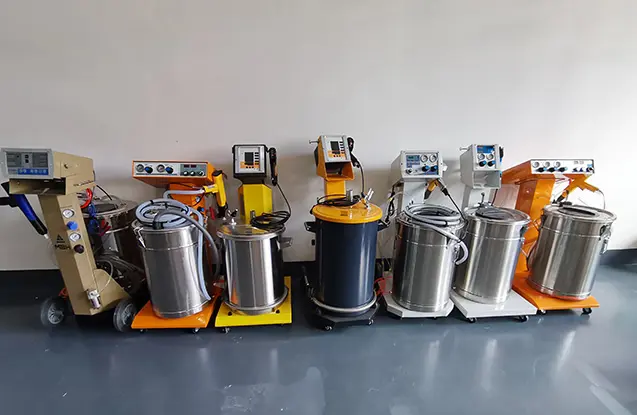There’s more going on inside a powder coating machine than meets the eye. Beneath that steady spray lies a mix of physics and clever engineering that makes or breaks the final finish. Knowing what truly drives powder flow can turn a decent coating setup into a flawless one.
Electrostatic Charge Dynamics and Their Role in Powder Adhesion
Inside every powder coating machine, there’s a bit of electrical wizardry at work. As powder particles are sprayed, they pick up an electrostatic charge—usually negative. The grounded metal part waiting for its finish carries a positive or neutral charge, attracting the powder like a magnet. But the strength and stability of that charge can make or break how well the powder sticks. If the charge is weak, uneven, or interrupted by moisture in the air, the result could be a thin, patchy coat.
Even the distance between the gun tip and the surface can shift how the charge behaves. If the powder exits the gun too quickly or is forced through a poorly adjusted electrode, its charge may not hold. That’s why experienced technicians fine-tune voltage settings and watch humidity levels closely. A quality powder coating machine includes controls to stabilize electrostatics, helping ensure each particle lands where it should—and stays there.
Particle Fluidization Patterns Within Spray Application Systems
Powder doesn’t move like a liquid, but inside a powder coating machine, it has to act a lot like one. That’s where fluidization comes in. Air is pushed through a porous membrane beneath the powder, loosening the particles and suspending them in motion. This makes them behave almost like a bubbling liquid, helping them flow smoothly to the spray gun without clogging or clumping.
If the fluidization pattern is uneven—too much air, not enough consistency—some particles rise faster, while others settle. This leads to a jerky, unpredictable spray pattern. A balanced fluid bed inside the machine keeps particles in constant, even motion. By tweaking airflow and bed depth, operators keep the powder perfectly suspended, which improves spray stability and coating control.
Cohesion and Agglomeration Effects Influencing Spray Consistency
Tiny powder particles don’t always like to stay apart. Especially under humid conditions, they tend to stick together, forming clusters known as agglomerates. This happens because of van der Waals forces—tiny electrical attractions between particles. Once powders clump, they’re harder to fluidize, harder to spray, and harder to coat with.
Inside a powder coating machine, these clumps can sneak through the system, clog spray guns, or leave a grainy finish. To prevent that, engineers rely on controlled air pressure, anti-static additives, and optimized feed hoppers. Some advanced systems even use vibrators or mechanical stirrers to break apart these clusters before they reach the spray gun. Managing particle cohesion isn’t just about equipment—it’s about paying attention to environment, powder age, and how long it’s been recycled.
Impact of Powder Particle Morphology on Coating Uniformity
The shape of powder particles directly impacts how well a powder coating machine performs. Round particles flow easily, pick up charges efficiently, and create smooth coatings. In contrast, jagged or irregular particles may resist fluidization, build up in corners of the hopper, or fly unevenly from the gun. They also tend to collect in the machine’s filters more quickly, which interrupts production.
Uniform coating isn’t just about coverage—it’s about how consistently each spray lays down the powder. A mix of shapes and sizes can lead to uneven layers. That’s why manufacturers often classify powders into tight particle size ranges and test their behavior before use. Choosing the right powder blend can often correct application issues without needing to replace expensive hardware.
Influence of Air Velocity Control on Powder Application Quality
- Too much air velocity causes overspray and poor edge coverage
- Too little air leads to sputtering and inconsistent finish
Every powder coating machine relies on controlled air movement to carry powder from the hopper to the surface. The velocity of that air affects both how the powder exits the gun and how it behaves once airborne. Too much air pressure, and powder flies past the part. Too little, and it clings inside the tubing, never reaching the target.
Carefully tuned velocity ensures an even, soft cloud that wraps around the part gently, allowing electrostatic forces to do their job. Many modern systems let users dial in PSI settings with extreme precision. A small adjustment in velocity can sharpen corners, improve transfer efficiency, and reduce waste.
Hopper Design Factors Affecting Powder Dispersion Efficiency
- Sloped walls help reduce powder bridging
- Internal baffles guide flow and minimize dead zones
Powder starts its journey in the hopper, and its flow from there affects everything else. A poorly designed hopper can lead to powder bridging—where particles form an arch and stop flowing—or funneling, where only the center feeds through. These hiccups disrupt spray consistency and frustrate operators.
Good hopper design supports smooth powder flow with sloped walls, agitation systems, and even air jets to stir or loosen stuck particles. Some hoppers include sensors that measure fill level and pressure to keep the feed steady. Powder coating machines that prioritize hopper design help maintain coating quality across long production runs. A steady flow keeps the spray even, the finish smooth, and the workday stress-free.

